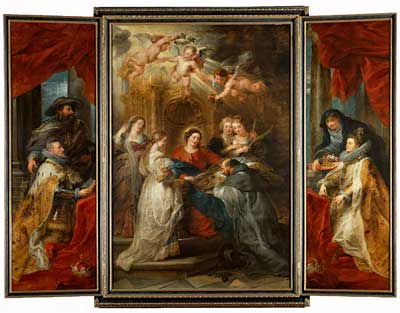|
Peter Paul Rubens (1577-1640)
The Ildefonso-Altarpiece
c. 1630/32
acquired in 1777
© Kunsthistorisches Museum, Vienna
Isabella Clara Eugenia, the regent of the Spanish Netherlands, commissioned this triptych for the altar of the Ildefonso Brotherhood in the church of St. Jacob op de Coudenberg at Brussels. The Brotherhood had been founded by her deceased husband, Archduke Albrecht, with the aim of venerating St. Ildefonso and stimulating loyalty to the House of Habsburg.
The central panel flanked by the opened wings depicts a scene from the life of St. Ildefonso: the Virgin bathed in heavenly light miraculously appeared to him in his own church and handed him a vestment. The rendering of the saint's devotion with which he receives this heavenly gift documents Rubens ability to depict and combine in magical unity sacred matters and human emotions. On the wings kneel in princely splendor Archduke Albrecht and his wife; both are being presented to the Virgin by their respective patron saints, St. Albrecht and St. Elisabeth of Hungary.
A triptych is an unusual choice for a Baroque artist. However, this format allows Rubens to separate the heavenly from the earthly sphere, while at the same time emphasizing the monument-like character of the painting. The preliminary model now in the Hermitage shows an earlier version of the evolving composition - here still envisaged undivided on a single panel. The exterior wings of the closed altar depict the Holy Family resting under an apple tree; today, the exterior panels have been removed and are exhibited separately.
|
